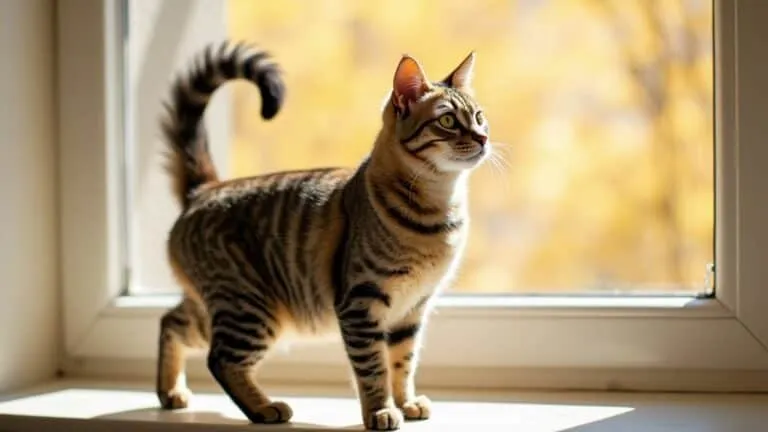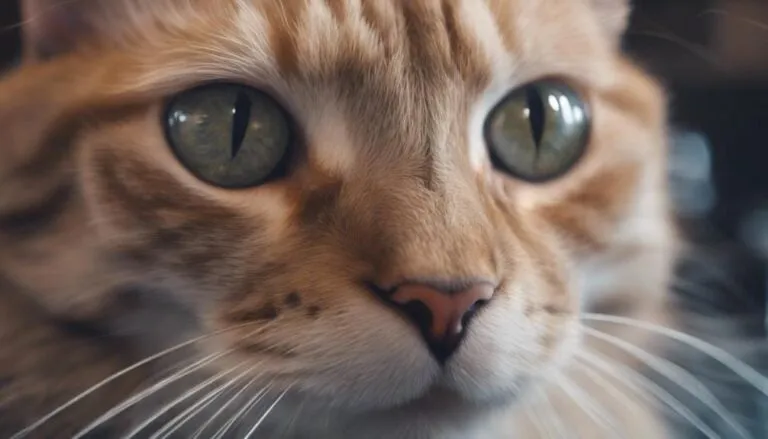The Best Fluffy Pancakes recipe you will fall in love with. Full of tips and tricks to help you make the best pancakes.

Are you aware that your aging cat may be silently experiencing feline arthritis, a condition that causes pain and discomfort in their joints? While you may not see any visible signs, your beloved feline companion could be suffering in silence.
In this discussion, we will uncover the hidden world of feline arthritis, revealing the signs, causes, and diagnosis of this often overlooked condition. You'll be surprised to learn that arthritis can affect cats of all ages, not just the elderly, and understanding the subtle cues and taking necessary steps can help alleviate their pain.
So, let's unravel the mystery of feline arthritis together and ensure your furry friend's well-being.
Key Takeaways
- Arthritis is a common condition in cats, with a high prevalence in older cats.
- Cats can develop arthritis at any age, including as young as one year old.
- Signs of arthritis in cats include reduced mobility, limping, muscle wasting, swollen joints, and difficulty jumping.
- Factors such as obesity, genetics, improper joint development, and injuries can contribute to the development of arthritis in cats.
What Is Arthritis?
What exactly is arthritis, and how does it affect cats as they age?
Understanding arthritis in cats is crucial for pet owners to ensure the well-being of their feline companions.
Arthritis, also known as degenerative joint disease, occurs when the cartilage on the joints wears away. Cartilage acts as a cushion between bones, preventing rubbing and providing smooth movement.
As cats age, the risk of developing arthritis increases. In fact, a study found that 61% of cats over the age of 6 had osteoarthritis in at least one joint.
Treatment options for feline arthritis include medications such as pain relievers and anti-inflammatory drugs. Weight management and exercise can also help manage arthritis in cats.
It's important to consult a veterinarian for a proper diagnosis and to explore alternative therapies like acupuncture or physical therapy.
Understanding arthritis in cats and the available treatment options is essential for providing the best care for aging feline friends.
Age and Prevalence of Feline Arthritis
Feline arthritis is more prevalent in older cats, with a higher chance of developing as they age. However, it's important to note that arthritis can occur in cats at any age, including younger cats.
Here are some important points to consider regarding age and the prevalence of feline arthritis:
- Preventing feline arthritis: While it may not be possible to completely prevent arthritis in cats, there are certain steps you can take to minimize the risk. This includes providing a balanced diet to maintain a healthy weight, ensuring regular exercise to keep joints mobile, and avoiding injuries that can lead to arthritis later in life.
- Managing arthritis in younger cats: If your younger cat develops arthritis, it's important to seek veterinary care for proper diagnosis and treatment. Your vet may recommend medications for pain relief and inflammation, as well as weight management and exercise plans tailored to your cat's needs. Alternative therapies such as acupuncture or physical therapy may also be beneficial in managing arthritis in younger cats.
- Regular check-ups: It's important to monitor your cat's mobility and activity levels as they age, and to be vigilant for any signs of lameness, limping, or changes in grooming habits. Regular check-ups with your veterinarian can help detect arthritis early and ensure appropriate management strategies are in place.
- Consult a veterinarian: If you suspect arthritis in your cat, it's always best to consult a veterinarian. They can perform a physical examination, conduct imaging tests if necessary, and provide treatment options tailored to your cat's specific needs.
Recognizing Signs of Arthritis in Cats
As your cat ages, it's important to be aware of the signs that may indicate arthritis, a common condition that can affect cats of all ages. Early intervention for feline arthritis is crucial to manage the pain and slow down the progression of the disease. Recognizing the signs of arthritis in cats can help you provide the necessary care and support for your furry friend.
Keep an eye out for limping, muscle wasting, swollen joints, stiffness, and difficulty jumping. Arthritic cats may also have an unkempt appearance, show decreased appetite, and have reduced grooming habits. If you suspect arthritis in your cat, consult with a veterinarian for a proper diagnosis and treatment plan.
For senior cats, managing arthritis may involve weight management, regular exercise, pain relievers, anti-inflammatory drugs, and alternative therapies such as acupuncture or physical therapy. By taking proactive steps, you can help improve your cat's quality of life and ensure their comfort.
Common Causes of Arthritis in Cats
Common causes of arthritis in cats can include factors such as:
- Obesity: Excess weight puts strain on joints and increases the risk of arthritis.
- Improper joint development: Cats with abnormal joint structure or development are more prone to developing arthritis.
- Orthopedic surgery or injury history: Cats who've undergone surgery or experienced joint injuries are at higher risk.
- Genetic predisposition: Certain breeds may have a higher likelihood of developing arthritis.
- Natural wear and tear on joints: As cats age, their joints naturally deteriorate, leading to arthritis.
Preventing feline arthritis involves maintaining a healthy weight, providing a balanced diet, and engaging in regular exercise.
Managing arthritis in younger cats requires early detection, proper diagnosis, and implementing a treatment plan that may include medication, weight management, and alternative therapies.
Checklist for Assessing Arthritis in Cats
To assess whether your cat may be experiencing arthritis, you can use a simple checklist to observe their mobility and behavior. Early detection of arthritis in cats is crucial for effective management and to prevent further joint damage.
Start by monitoring your cat's ability to jump, climb stairs, chase prey, and run. Keep a record of any changes in their mobility and activity levels as they age. Pay attention to signs of lameness or limping, changes in appetite or weight, and alterations in grooming habits.
It's also helpful to record videos of your cat's movements to show your veterinarian. If you suspect arthritis, consult a veterinarian for a comprehensive assessment and treatment options. Managing arthritis in cats may involve medications, weight management, exercise, and alternative therapies like acupuncture or physical therapy.
Diagnosis and Veterinary Treatment
To accurately diagnose feline arthritis and determine the appropriate veterinary treatment, a thorough physical examination by a veterinarian, along with possible imaging techniques, is essential.
Here are some veterinary recommendations and long-term care options for cats with arthritis:
- Medications: Your veterinarian may prescribe pain relievers and anti-inflammatory drugs to manage your cat's pain and reduce inflammation in the joints.
- Weight management: Maintaining a healthy weight is crucial for cats with arthritis. Your vet may recommend a special diet and exercise plan to help your cat maintain a healthy weight and reduce the stress on their joints.
- Environmental modifications: Making changes to your cat's environment can help minimize the impact on their arthritic joints. This may include providing soft bedding, ramps or steps for easier access to furniture, and litter boxes with low sides.
- Alternative therapies: Acupuncture, physical therapy, and other alternative therapies may be recommended to help improve your cat's mobility and provide pain relief.
Medication and Management Options
When it comes to managing feline arthritis, there are several medication and management options available to help alleviate pain and improve your cat's mobility.
Medications such as pain relievers and anti-inflammatory drugs are commonly prescribed by veterinarians to reduce inflammation and discomfort. These medications can provide significant relief for your cat, but it's important to be aware of potential side effects. Some cats may experience digestive upset or liver and kidney issues when taking certain medications. It's crucial to closely monitor your cat and consult with your veterinarian if you notice any adverse reactions.
In addition to medication, long-term care options play a vital role in managing feline arthritis. Weight management is crucial to reduce stress on your cat's joints, so maintaining a healthy weight through a balanced diet and regular exercise is essential. Alternative therapies like acupuncture or physical therapy may also be recommended to improve your cat's mobility and overall comfort.
Alternative Therapies for Arthritis Relief
Managing feline arthritis involves not only medication options but also alternative therapies for arthritis relief, which can provide additional support in reducing pain and improving mobility for your cat. Consider the following alternative therapies that have shown benefits in treating feline arthritis:
- Acupuncture: This traditional Chinese medicine practice involves inserting thin needles into specific points on the body. Acupuncture can help stimulate the release of natural pain-relieving chemicals and improve blood circulation, providing relief for arthritic cats.
- Physical therapy: Physical therapy for cats with arthritis focuses on exercises and stretches to improve joint flexibility and strengthen muscles. It can help reduce pain, increase range of motion, and improve overall mobility. Your veterinarian or a specialized therapist can guide you on specific exercises to perform with your cat.
- Laser therapy: This non-invasive treatment uses low-level laser light to stimulate the body's natural healing process. It can help reduce inflammation and pain associated with arthritis, promoting a faster recovery and improved mobility.
- Massage therapy: Gentle massage techniques can help relax muscles, reduce pain, and improve circulation in cats with arthritis. It can also provide comfort and stress relief for your cat.
These alternative therapies, when used in conjunction with proper medication and management options, can contribute to a comprehensive approach in managing feline arthritis and improving your cat's quality of life.
Frequently Asked Questions
Can Cats With Arthritis Still Live a Comfortable and Happy Life?
Yes, cats with arthritis can still live a comfortable and happy life. There are holistic approaches for cat arthritis relief, such as weight management, exercise, pain relievers, anti-inflammatory drugs, acupuncture, and physical therapy.
Are Certain Cat Breeds More Prone to Developing Arthritis?
Certain cat breeds may have a higher prevalence of developing arthritis. Factors such as body structure, genetics, and improper joint development can contribute. It is important to monitor your cat's health and consult a veterinarian if you suspect arthritis.
Can Arthritis in Cats Be Prevented or Slowed Down?
To prevent or slow down arthritis in cats, you can use prevention techniques like maintaining a healthy weight and providing regular exercise. Additionally, natural supplements such as omega-3 fatty acids and glucosamine can help support joint health.
How Can I Help Manage My Cat's Weight to Prevent or Alleviate Arthritis Symptoms?
To help manage your cat's weight and prevent or alleviate arthritis symptoms, focus on weight management through portion control and a balanced diet. Incorporate regular exercise routines tailored to your cat's abilities and consult with your vet for specific recommendations.
What Are Some Alternative Therapies That Can Provide Relief for Cats With Arthritis?
Acupuncture and massage therapy are alternative therapies that can provide relief for cats with arthritis. These treatments can help reduce pain, improve joint mobility, and promote relaxation. Consult with a veterinarian to determine the best approach for your cat.
Conclusion
In conclusion, feline arthritis is a silent pain that can affect cats of all ages, not just the elderly. By recognizing the signs such as reduced activity and changes in grooming habits, you can help detect and manage this condition.
With proper diagnosis and veterinary treatment, along with medication and management options, you can ensure your furry friend's quality of life is maximized.
Consider alternative therapies for arthritis relief to provide your aging cat with the comfort they deserve.








